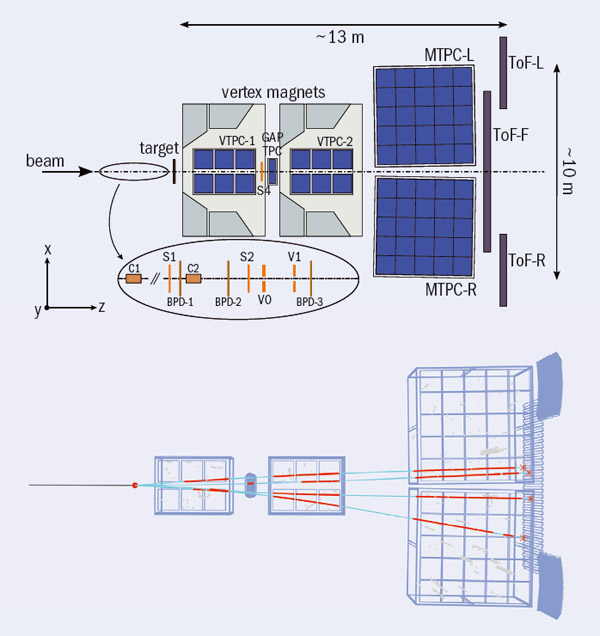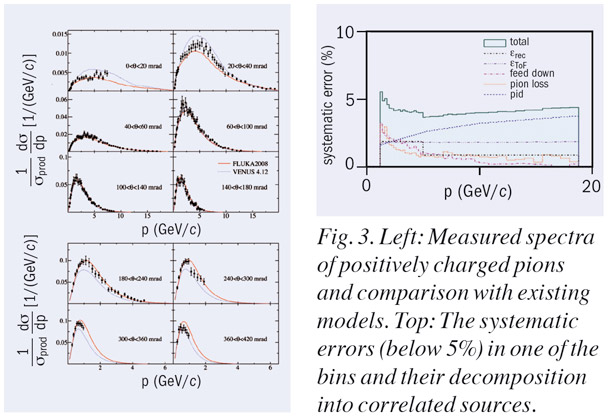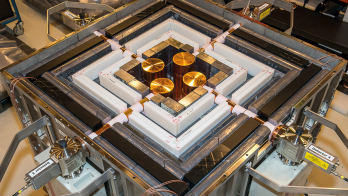A CERN experiment brings together heavy-ion and neutrino experts.

Accelerator neutrino beams are currently the object of intense discussion and development. They provide a necessary tool for the detailed study of neutrino oscillations and in particular the observation of potential CP-violating effects that are born from the interference of transitions among the three known species of neutrino. Neutrino interaction cross-sections are tiny, so the challenge in studying their properties has been to produce ever increasing beam intensities. The next challenge in neutrino physics will be to establish precisely the parameters of the oscillations and then compare the oscillations of neutrinos with anti-neutrinos (or the oscillation probability as a function of neutrino energy) to search for CP-violation. This will require precise measurements of the transitions of neutrinos into each other, which will in turn demand a much better knowledge of the neutrino beams.
At present – and probably for the next decade – neutrino beams are generated by the conventional technique: a beam of multi-giga-electron-volt protons, as powerful as possible (up to around 500 kW beam power), is directed at a target to produce a large number (1012 or more) of hadrons, mainly pions with a small admixture (5–10%) of kaons. These are then focused in the direction desired for the neutrino beam and they decay – producing neutrinos – in a decay tunnel.
In the absence of a good theory of hadronic interactions, a precise prediction of the properties of such neutrino beams requires measurements of particle production at an unprecedented level of precision. The role of the NA61/SHINE experiment at CERN’s Super Proton Synchrotron (SPS) is to perform these hadron production measurements. More specifically, it has taken data for the T2K experiment in Japan, both with a thin carbon target and a full replica of the target used in T2K. These data have already proved important for the extraction of the first results on electron-neutrino appearance and muon-neutrino disappearance in T2K. As statistics increase in T2K, they will become more and more essential.

The collaboration behind the SPS Heavy Ion and Neutrino Experiment (SHINE, approved at CERN as NA61) is an unlikely marriage between aficionados of the heaviest and lightest beams on offer. Ions as heavy as lead nuclei have been accelerated in the SPS, while neutrinos have the lightest mass (now famously non-zero) of all particles apart from photons. So what is the unifying concept between these communities that are a priori so different?
The NA49 detector in CERN’s North Area offers excellent tracking with its immense set of time-projection chambers (TPCs), time-of-flight (TOF) detectors and flexible beamline. To perform systematic measurements at energies at the onset of quark–gluon plasma creation, the heavy-ion physicists were interested in upgrading the detector to allow higher event statistics and lower systematic uncertainties. At the same time, neutrino physicists, attracted by the extensive coverage of the detector, were interested in running it in a simple configuration, but also with high statistics, so as to have the first data ready in time for the start of T2K.
The main upgrades relevant for all of the NA61/SHINE physics programmes concerned the TPC read-out, an extension of the TOF detectors and an upgrade of the trigger and data-acquisition system. Figure 1 shows the upgraded detector. Its acceptance fully covers the kinematic region of interest for T2K.
The NA61/SHINE experiment was approved in April 2007 and took data in a pilot run the following September, with 600,000 triggers on the thin carbon target and 200,000 triggers on the replica (long) T2K target. More extensive data-taking for the T2K physics programme took place in 2009 and 2010, both with thin (6 million triggers in 2009) and long targets (10 million triggers in 2010). In parallel, data were recorded for the NA61/SHINE heavy-ion and cosmic-ray programmes.
As a first priority, the cross-sections for producing charged pions from 30 GeV protons on carbon were measured with the thin-target data taken in 2007 (Abgrall et al. 2011). The systematic errors are typically in the range of 5–10% and smaller than the statistical errors. These data have already been used for an improved prediction of the neutrino flux in T2K (Abe et al. 2011). Furthermore, they also provide important input to improve the hadron-production models needed for the interpretation of air showers initiated by ultra-high-energy cosmic rays.

However, these first NA61/SHINE measurements provide only a part of what is needed to predict the neutrino flux in T2K. A substantial fraction of the high-energy flux, and in particular the electron-neutrino contamination, originates from the decay of kaons. Charged kaons are readily identified in NA61/SHINE from the suite of particle-identification techniques – dE/dx in the TPC and the TOF in the upgraded detector (see figure 2) – and a first set of cross-sections has been produced already. Neutral kaons can be reconstructed using the V0-like topology of K0S→ π+π– decays.
A large fraction (up to 40%) of the neutrinos originates from particles produced by re-interactions of secondary particles in the target, which for T2K is 90 cm long. This is difficult to calculate precisely and it motivates a careful analysis of the data taken with the long target. Long-target data are notoriously more difficult to reconstruct and analyse but they provide much more directly the information needed for extracting the neutrino flux. The NA61/SHINE collaboration presented a pilot analysis at the NUFACT meeting at CERN in early August (Abgrall 2011). The ultimate precision will come from the full analysis of the long-target data taken in 2010. The collaboration is working hard to complete these analyses in time for the high-statistics measurements that will become possible in T2K when the experiment resumes data-taking after recovering from damage in the massive earthquake in north-eastern Japan that occurred in March this year.








